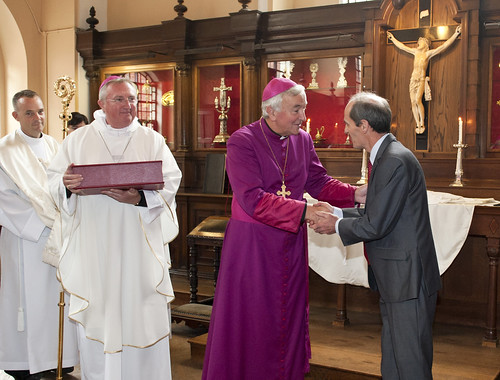DOMINICA IN PALMIS DE PASSIONE DOMINI
Praefatio
Vere dignum et iustum est, aequum et salutare,
nos tibi semper et ubique gratias agere:
Domine, sancte Pater, omnipotens aeterne Deus:
per Christum Dominum nostrum.
Qui pati pro impiis dignatus est innocens,
et pro sceleratis indebite condemnari.
Cuius mors delicta nostra detersit,
et iustificationem nobis resurrectio comparavit.
Unde et nos cum omnibus Angelis te laudamus,
iucunda celebratione clamantes:
:: MR p. 235; Moeller 1138.
:: MA 96/6, p. 212.
LITURGICAL ANTECEDENTS:
% MR 1970 : Dominica in Palmis de Passione Domini. Praefatio (Pr):
With variant concluding protocol:
Quem caeli et terra, quem Angeli et Archangeli
confitentur et proclamant, incessabili voce dicentes:
% Sup 1585 :
VD per Christum Dominum nostrum.
Qui innocens pro impiis voluit pati,§
et pro sceleratis indebite condemnari.
Cuius mors delicta nostra detersit,
et resurrectio iustificationem nobis exhibuit.§
Per quem tuam pietatem supplices exoramus,
ut sic nos hodie a peccatis emacules,
ut cras venerabilis cenae dapibus saties.
Hodie acceptes confessionem nostrorum peccaminum,
et cras tribuas spiritalium incrementa donorum.
Hodie ieiuniorum nostrorum vota suscipias,
et cras nos ad sacratissimae cenae convivium introducas.
Per quem maiestatem.
% LMS 568 : LXIII. Missa de IIIIe Feria ante Cena Domini (Pr):
VD per Christum Dominum nostrum.
Qui innocens pro impiis voluit pati,§
et pro sceleratis indebite condemnari.
Qui latroni deprecanti omisit peccatum,
promittens ei voluntate gratissima paradisum.
Cuius mors delicta nostra detersit,
et resurrectio iustificationem nobis exhibuit.§
Ob hoc te, Deus noster, exposcimus
ut hodie omittas nobis peccata nostra,
et cras reficias dulcedine tua.
Hodie nostrorum peccaminum confessionem accepta,
et cras donorum spiritalium tribue incrementa.
Hodie quidquid odis a nostris corporibus abiice,
et cras nos refice vulneribus crucis tuae.
Hodie os nostrum reple gaudio,
et linguam nostram exultatione:
qualiter nunc et usque in aeternum
laudemus te piissimum Salvatorem,
proclamentes atque ita dicentes:
:: Ambrosian parallels : Berg 480; Missale Duplex p. 210.
BIBLICAL CONTEXT:
Is 53, 7-9:
Oblatus est quia ipse voluit, et non aperuit os suum; sicut ovis ad occisionem ducetur, et quasi agnus coram tondente se obmutescet, et non aperiet os suum. <...> quia abscissus est de terra viventium. Propter scelus populi mei percussi eum. <...> eo quod iniquitatem non fecerit, neque dolus fuerit in ore eius.
Io 8, 46:
Quis ex vobis arguet me de peccato?
Rom 4, 23-25:
Non est autem scriptum tantum propter ipsum, quia reputatum est illi ad iustitiam, sed et propter nos, quibus reputabitur credentibus in eum qui suscitavit Iesum Christum Dominum nostrum a mortuis, qui traditus est propter delicta nostra, et resurrexit propter iustificationem nostram.
2 Cor 5, 21:
Eum qui non noverat peccatum, pro nobis peccatum fecit, ut nos efficeremur iustitia Deo in ipso.
Heb 7, 26:
Talis enim decebat ut nobis esset pontifex, sanctus, innocens, impollutus, segregatus a peccatoribus, et excelsior caelis factus, qui non habet necessitatem cotidie, quedadmodum sacerdotes, prius pro suis delictis hostias offerre deinde pro populo; hoc enim fecit semel seipsum offerendo.
1 Pet 2, 21-24:
In hoc enim vocati estis, quia et Christus passus est pro nobis, vobis relinquens exemplum, ut sequemini vestigia eius. Qui peccatum non fecit, nec inventus est dolus in ore eius; qui cum malediceretur, non maledicebat; cum pateretur, non comminabatur, tradebat autem iudicanti se iniuste; qui peccata nostra ipse pertulit in corpore suo super lignum, ut peccatis mortui, iustitiae vivamus: cuius livore sanati estis.
1 Pet 3, 18:
Quia et Christus semel pro peccatis nostris mortuus est, iustus pro iniustis, ut nos offeret Deo, mortificatus quidem carne, vivificatus autem spiritu.&
1 Io 3, 5:
Et scitis quia ille apparuit ut peccata nostra tolleret, et peccatum in eo non est.&
PATRISTIC WITNESS:
Ambrosius, De Spiritu Sancto 1, 9, 111. 114 (PL 16, 730-731):
Quis est igitur cuius vulnere plagarum sanati sumus, nisi Christus Dominus: de quo idem prophetavit Isaias quia plaga eius nostra medicina est (Is 53, 5): de quo Paulus Apostolus in epistolis suis scripsit: `qui peccatum non cognovit sed pro nobis peccatum factus est' (2 Cor 5, 21)? Hoc quippe divinum in eo, quia caro peccatum non fecit, nec in eo suscepti corporis creatura peccavit. Nam quid mirum, si non peccavit sola divinitas, cum peccandi incentiva non habeat? Si autem solus exsors peccati Deus, omnis utique creatura per natura sui, ut diximus obnoxia potest esse peccator <...> Denique ut sciamus communis hoc redemptionis mysterium per prophetas evidentissime revelatum, etiam hoc loco habes dictum: `Ecce abstulit peccata tua' (Zac 3, 4); non quod Christus peccata sua deponeret, qui peccatum non fecit; sed quod in carne Christi omne a peccatis suis genus absolveretur humanum.
Augustinus, Sermo 22, 9 (PL 38, 155):
Est autem misericordia abundantissima, et larda eius benevolentia, qui nos sanguine Filii sui redemit, cum propter peccata nostra nihil essemus. Nam ipse aliquid magnum fecit, cum hominem ad imaginem et similitudinem suam creavit. Sed quia nos nihil fieri voluimus peccando, et traducem mortalitatis de parentibus duximus: placuit tamen illi per misericordiam suam redimere nos tanto pretio: dedit pro nobis sanguinem Unici sui innocenter viventis, innocenter mortui.
PRINCIPAL VOCABULARY:
patior impius innocens sceleratus indebite condemno mors delictum detergeo iustificatio resurrectio comparo



